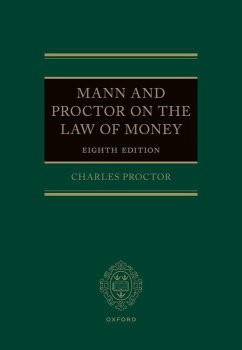Charles Proctor
Mann and Proctor on the Legal Aspect of Money 8e
Schade – dieser Artikel ist leider ausverkauft. Sobald wir wissen, ob und wann der Artikel wieder verfügbar ist, informieren wir Sie an dieser Stelle.
Charles Proctor
Mann and Proctor on the Legal Aspect of Money 8e
- Gebundenes Buch
- Merkliste
- Auf die Merkliste
- Bewerten Bewerten
- Teilen
- Produkt teilen
- Produkterinnerung
- Produkterinnerung
The eighth edition of this leading work on all private and public law aspects relating to money has been thoroughly revised to include consideration of the impact of Brexit, virtual currencies and also includes new materials on the role of central banks.
Andere Kunden interessierten sich auch für
![Fa Mann Fa Mann]() Fa Mann189,99 €
Fa Mann189,99 €![Elisabeth Mann Borgese and the Law of the Sea Elisabeth Mann Borgese and the Law of the Sea]() Tirza MeyerElisabeth Mann Borgese and the Law of the Sea139,99 €
Tirza MeyerElisabeth Mann Borgese and the Law of the Sea139,99 €![Injuries of the Eye and Their Medico-Legal Aspect Injuries of the Eye and Their Medico-Legal Aspect]() Ferdinand Von ArltInjuries of the Eye and Their Medico-Legal Aspect35,99 €
Ferdinand Von ArltInjuries of the Eye and Their Medico-Legal Aspect35,99 €![Money Laundering Compliance Money Laundering Compliance]() Tim BennettMoney Laundering Compliance231,99 €
Tim BennettMoney Laundering Compliance231,99 €![Partnership and Llp Law 8e Partnership and Llp Law 8e]() Geoffrey MorsePartnership and Llp Law 8e142,99 €
Geoffrey MorsePartnership and Llp Law 8e142,99 €![How the Public Are Plundered by Promoters of Companies, Foreign States, Syndicates, and Money-Lenders How the Public Are Plundered by Promoters of Companies, Foreign States, Syndicates, and Money-Lenders]() Axford PackerHow the Public Are Plundered by Promoters of Companies, Foreign States, Syndicates, and Money-Lenders36,99 €
Axford PackerHow the Public Are Plundered by Promoters of Companies, Foreign States, Syndicates, and Money-Lenders36,99 €![A socio legal investigation on the relationship between corruption and underdevelopment in Nigeria A socio legal investigation on the relationship between corruption and underdevelopment in Nigeria]() Noble EyisiA socio legal investigation on the relationship between corruption and underdevelopment in Nigeria23,99 €
Noble EyisiA socio legal investigation on the relationship between corruption and underdevelopment in Nigeria23,99 €-
-
The eighth edition of this leading work on all private and public law aspects relating to money has been thoroughly revised to include consideration of the impact of Brexit, virtual currencies and also includes new materials on the role of central banks.
Produktdetails
- Produktdetails
- Verlag: Oxford University Press
- 8th edition
- Seitenzahl: 918
- Erscheinungstermin: 23. März 2023
- Englisch
- Abmessung: 248mm x 177mm x 51mm
- Gewicht: 1694g
- ISBN-13: 9780198804925
- ISBN-10: 019880492X
- Artikelnr.: 56727608
- Herstellerkennzeichnung
- Libri GmbH
- Europaallee 1
- 36244 Bad Hersfeld
- gpsr@libri.de
- Verlag: Oxford University Press
- 8th edition
- Seitenzahl: 918
- Erscheinungstermin: 23. März 2023
- Englisch
- Abmessung: 248mm x 177mm x 51mm
- Gewicht: 1694g
- ISBN-13: 9780198804925
- ISBN-10: 019880492X
- Artikelnr.: 56727608
- Herstellerkennzeichnung
- Libri GmbH
- Europaallee 1
- 36244 Bad Hersfeld
- gpsr@libri.de
Charles Proctor is a Solicitor and partner in Fladgate LLP. He has specialised in banking and financial services for most of his career. In addition to Mann and Proctor on the Law of Money, he has also published two editions of his text, The Law and Practice of International Banking. He has also published a range of articles on diverse subjects such as the European single currency, central bank immunity, and similar matters.
* I THE CONCEPT OF MONEY AND MONETARY SYSTEMS
* 1: The Concept of Money
* 2: The Organisation of the Monetary System
* 3: The Role of the Central Bank
* 4: Payment Systems
* II THE PRIVATE LAW OF MONETARY OBLIGATIONS
* 5: The Character of Monetary Obligations
* 6: Monetary Obligations and the Conflict of Laws
* 7: The Interpretation of Monetary Obligations - Initial Uncertainty
* 8: The Interpretation of Monetary Obligations - Subsequent
Uncertainty
* 9: Interest
* 10: The Performance of Monetary Obligations
* 11: Legal Proceedings and their Effect upon Monetary Obligations
* III THE PRINCIPLE OF NOMINALISM
* 12: Monetary Obligations, Liquidated Sums, and the Principle of
Nominalism
* 13: Monetary Obligations - Unliquidated Amounts
* 14: Excluding the Effects of Nominalism
* 15: Nominalism, Legislation and Public Policy
* 16: Nominalism, Private International Law, and the Lex Monetae
Principle
* IV EXCHANGE CONTROLS, EXCHANGE RATES AND SANCTIONS
* 17: Exchange Control - The UK Model
* 18: Exchange Control under the International Monetary Fund Agreement
* 19: The Private International Law of Exchange Control
* 20: Sanctions and Monetary Obligations
* 21: Exchange Rates
* V PUBLIC INTERNATIONAL LAW OF MONEY
* 22: Monetary sovereignty
* 23: The Protection of Foreign Currency Systems
* 24: The Protection of Foreign Monetary Institutions
* 25: International Rules of Monetary Conduct
* 26: The Monetary Law of Interstate Obligations
* VI MONETARY UNIONS AND OTHER FORMS OF MONETARY ORGANISATION
* 27: The Nature and History of Monetary Unions
* 28: Historical Background to EMU
* 29: EMU and the Treaty on European Union
* 30: The Institutional Framework of Monetary Union
* 31: The Single Currency and its Treaty Framework
* 32: The Euro Regulations
* 33: Monetary Union and Monetary Obligations
* 34: The Euro and Monetary Sovereignty
* 35: Withdrawal from the Eurozone
* 36: Monetary Union-Lessons from the financial crisis
* 37: Other Forms of Monetary Organisation
* 1: The Concept of Money
* 2: The Organisation of the Monetary System
* 3: The Role of the Central Bank
* 4: Payment Systems
* II THE PRIVATE LAW OF MONETARY OBLIGATIONS
* 5: The Character of Monetary Obligations
* 6: Monetary Obligations and the Conflict of Laws
* 7: The Interpretation of Monetary Obligations - Initial Uncertainty
* 8: The Interpretation of Monetary Obligations - Subsequent
Uncertainty
* 9: Interest
* 10: The Performance of Monetary Obligations
* 11: Legal Proceedings and their Effect upon Monetary Obligations
* III THE PRINCIPLE OF NOMINALISM
* 12: Monetary Obligations, Liquidated Sums, and the Principle of
Nominalism
* 13: Monetary Obligations - Unliquidated Amounts
* 14: Excluding the Effects of Nominalism
* 15: Nominalism, Legislation and Public Policy
* 16: Nominalism, Private International Law, and the Lex Monetae
Principle
* IV EXCHANGE CONTROLS, EXCHANGE RATES AND SANCTIONS
* 17: Exchange Control - The UK Model
* 18: Exchange Control under the International Monetary Fund Agreement
* 19: The Private International Law of Exchange Control
* 20: Sanctions and Monetary Obligations
* 21: Exchange Rates
* V PUBLIC INTERNATIONAL LAW OF MONEY
* 22: Monetary sovereignty
* 23: The Protection of Foreign Currency Systems
* 24: The Protection of Foreign Monetary Institutions
* 25: International Rules of Monetary Conduct
* 26: The Monetary Law of Interstate Obligations
* VI MONETARY UNIONS AND OTHER FORMS OF MONETARY ORGANISATION
* 27: The Nature and History of Monetary Unions
* 28: Historical Background to EMU
* 29: EMU and the Treaty on European Union
* 30: The Institutional Framework of Monetary Union
* 31: The Single Currency and its Treaty Framework
* 32: The Euro Regulations
* 33: Monetary Union and Monetary Obligations
* 34: The Euro and Monetary Sovereignty
* 35: Withdrawal from the Eurozone
* 36: Monetary Union-Lessons from the financial crisis
* 37: Other Forms of Monetary Organisation
* I THE CONCEPT OF MONEY AND MONETARY SYSTEMS
* 1: The Concept of Money
* 2: The Organisation of the Monetary System
* 3: The Role of the Central Bank
* 4: Payment Systems
* II THE PRIVATE LAW OF MONETARY OBLIGATIONS
* 5: The Character of Monetary Obligations
* 6: Monetary Obligations and the Conflict of Laws
* 7: The Interpretation of Monetary Obligations - Initial Uncertainty
* 8: The Interpretation of Monetary Obligations - Subsequent
Uncertainty
* 9: Interest
* 10: The Performance of Monetary Obligations
* 11: Legal Proceedings and their Effect upon Monetary Obligations
* III THE PRINCIPLE OF NOMINALISM
* 12: Monetary Obligations, Liquidated Sums, and the Principle of
Nominalism
* 13: Monetary Obligations - Unliquidated Amounts
* 14: Excluding the Effects of Nominalism
* 15: Nominalism, Legislation and Public Policy
* 16: Nominalism, Private International Law, and the Lex Monetae
Principle
* IV EXCHANGE CONTROLS, EXCHANGE RATES AND SANCTIONS
* 17: Exchange Control - The UK Model
* 18: Exchange Control under the International Monetary Fund Agreement
* 19: The Private International Law of Exchange Control
* 20: Sanctions and Monetary Obligations
* 21: Exchange Rates
* V PUBLIC INTERNATIONAL LAW OF MONEY
* 22: Monetary sovereignty
* 23: The Protection of Foreign Currency Systems
* 24: The Protection of Foreign Monetary Institutions
* 25: International Rules of Monetary Conduct
* 26: The Monetary Law of Interstate Obligations
* VI MONETARY UNIONS AND OTHER FORMS OF MONETARY ORGANISATION
* 27: The Nature and History of Monetary Unions
* 28: Historical Background to EMU
* 29: EMU and the Treaty on European Union
* 30: The Institutional Framework of Monetary Union
* 31: The Single Currency and its Treaty Framework
* 32: The Euro Regulations
* 33: Monetary Union and Monetary Obligations
* 34: The Euro and Monetary Sovereignty
* 35: Withdrawal from the Eurozone
* 36: Monetary Union-Lessons from the financial crisis
* 37: Other Forms of Monetary Organisation
* 1: The Concept of Money
* 2: The Organisation of the Monetary System
* 3: The Role of the Central Bank
* 4: Payment Systems
* II THE PRIVATE LAW OF MONETARY OBLIGATIONS
* 5: The Character of Monetary Obligations
* 6: Monetary Obligations and the Conflict of Laws
* 7: The Interpretation of Monetary Obligations - Initial Uncertainty
* 8: The Interpretation of Monetary Obligations - Subsequent
Uncertainty
* 9: Interest
* 10: The Performance of Monetary Obligations
* 11: Legal Proceedings and their Effect upon Monetary Obligations
* III THE PRINCIPLE OF NOMINALISM
* 12: Monetary Obligations, Liquidated Sums, and the Principle of
Nominalism
* 13: Monetary Obligations - Unliquidated Amounts
* 14: Excluding the Effects of Nominalism
* 15: Nominalism, Legislation and Public Policy
* 16: Nominalism, Private International Law, and the Lex Monetae
Principle
* IV EXCHANGE CONTROLS, EXCHANGE RATES AND SANCTIONS
* 17: Exchange Control - The UK Model
* 18: Exchange Control under the International Monetary Fund Agreement
* 19: The Private International Law of Exchange Control
* 20: Sanctions and Monetary Obligations
* 21: Exchange Rates
* V PUBLIC INTERNATIONAL LAW OF MONEY
* 22: Monetary sovereignty
* 23: The Protection of Foreign Currency Systems
* 24: The Protection of Foreign Monetary Institutions
* 25: International Rules of Monetary Conduct
* 26: The Monetary Law of Interstate Obligations
* VI MONETARY UNIONS AND OTHER FORMS OF MONETARY ORGANISATION
* 27: The Nature and History of Monetary Unions
* 28: Historical Background to EMU
* 29: EMU and the Treaty on European Union
* 30: The Institutional Framework of Monetary Union
* 31: The Single Currency and its Treaty Framework
* 32: The Euro Regulations
* 33: Monetary Union and Monetary Obligations
* 34: The Euro and Monetary Sovereignty
* 35: Withdrawal from the Eurozone
* 36: Monetary Union-Lessons from the financial crisis
* 37: Other Forms of Monetary Organisation








